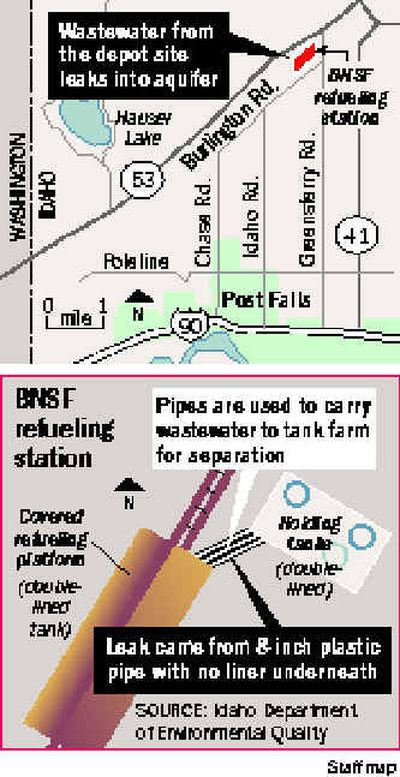Railroad ignored advice on pipe

In case of a catastrophic diesel spill, a $42-million state-of-the-art refueling depot sitting atop the region’s aquifer may rely on little more than single-walled plastic piping, according to state documents and reports from the railroad’s consultants.
Despite a recommendation from a state environmental engineer, Burlington Northern and Santa Fe Railway Co. placed no containment barrier beneath a system of pipes leading from a refueling platform to a cluster of lined tanks. If a spill occurs on the platform, the diesel fuel will be ferried by the plastic pipes about 400 feet to a holding tank, according to reports from the company’s engineering consultant.
The railroad carefully girded both the refueling platform and an adjoining tank farm where the wastewater is delivered – but not underneath the plastic pipes connecting the two sites. A BNSF spokesman confirmed the emergency plan.
“This system is used in similar industrial designs,” said Gus Melonas, the railroad’s spokesman.
It was one of those pipes that apparently was fractured during construction of the depot, leading to the Dec. 10 discovery that contaminated wastewater has apparently seeped into the aquifer.
While refueling operations continue, Melonas said the railroad has shut down the wastewater system and will use trucks to transport the diesel if a large spill occurs.
“In the event of a diesel spill at the platform, it would be collected into the collection trench and would be transferred by the trucks,” Melonas said.
An attorney for two environmental groups said the facility should be closed until an independent investigation of the construction is completed. Rachael Paschal Osborn, an attorney for Friends of the Aquifer and the local chapter of the Sierra Club, said BNSF’s emergency plan was “ridiculous.”
“It should be shut down until we know what is going on out there,” Osborn said. “We’re told that it’s state-of-the-art, but we keep getting feedback that in fact it isn’t.”
The design plans were in hundreds of pages of documents, analyses and internal e-mails made available by the Idaho Department of Environmental Quality in response to a public records request by The Spokesman-Review. The depot near Hauser, Idaho, is about 150 feet above the underground Spokane Valley-Rathdrum Prairie Aquifer, the sole source of drinking water for 400,000 people in North Idaho and Eastern Washington.
Earlier this month, BNSF discovered a leak in one of the plastic pipes, which carried water mixed with small amounts of fuel, oil and coolants. Preliminary samples indicate some contaminants reached the aquifer, but the company said it won’t know until next week the extent of the contamination.
The broken pipe was discovered on Dec. 10, but BNSF officials say it may have been damaged during construction before the facility opened on Sept. 1. BNSF said it does not know how long the pipe has been leaking.
Had a spill occurred during the time of the leak, diesel fuel would have been funneled through the wastewater pipes – including the broken one – to the holding tank, the railroad confirmed.
According to a 1997 memorandum from the consulting firm Hanson-Wilson Inc., the wastewater system “will catch incidental spills and any fuel tank overflows, platform washdown water, and any catastrophic failure on the platform.” The firm said Thursday that BNSF asked it not to talk with the media.
The state’s records repeatedly refer to the pipes as a wastewater treatment system designed to handle relatively small amount of contaminants washed from the locomotives as they sit idle. But the plastic pipes also function as emergency outlets, potentially handling thousands of gallons of fuel if a large spill occurs.
In 1998, a state environmental engineer urged the railroad to place containment barriers under the plastic pipes of the wastewater system.
In a Feb. 12, 1998, memorandum to the railroad’s consultant, state engineer Gary Gaffney informed the company that “a reliable containment barrier needs to be provided under all areas that involve wastewater or the potential for spills …”
Gaffney reviewed the memo on Thursday and confirmed that he made the recommendation. But the Idaho agency approved the project even though the railroad failed to follow through on the recommendation.
“We did approve it” without requiring the barrier, Gaffney said. “Our primary focus was the tank farm itself. It has the largest risk of having a catastrophic failure.”
He added, “At the time, it wasn’t a concern. The flow was not expected to be significant.”
Melonas said he did not immediately have details of the state’s recommendation. He declined to comment on whether the pipeline will be dug up to allow a containment barrier to be put in place.
Gaffney said Thursday it was unclear if the state had the authority to require a containment barrier under the wastewater system. According to company projections, each year the system will handle nearly a million gallons of water, containing 1 to 2 percent fuel and diesel.
The railroad’s plan to place the 500,000-gallon refueling depot above the aquifer drew widespread criticism from the public, an Idaho hearing examiner and Idaho health officials. But Kootenai County commissioners approved the depot in 2000.
In a 1997 e-mail, a state engineer said the railroad’s own consultant “suggested to BN that they consider a site located off the Rathdrum Prairie aquifer and was laughed at.”
A hydrogeologist retained by the railroad testified at a public hearing the depot would not threaten the region’s drinking water. According to a 1999 analysis of spill scenarios by Farr Associates, “the chance of an accidental diesel release occurring over an unlined area at the proposed facility is extremely small.”
Under the terms of the county permit, the railroad will provide an alternative source of drinking water should the aquifer be contaminated. In the documents made available Thursday, the company suggested bottled water could be provided.